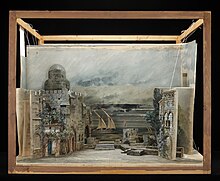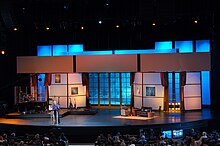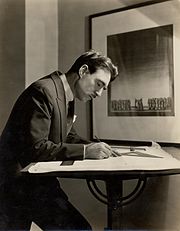| This article needs additional citations for verification. Please help improve this article by adding citations to reliable sources. Unsourced material may be challenged and removed. Find sources: "Scenic design" – news · newspapers · books · scholar · JSTOR (October 2020) (Learn how and when to remove this message) |




Scenic design, also known as stage design or set design, is the creation of scenery for theatrical productions including plays and musicals. The term can also be applied to film and television productions, where it may be referred to as production design. Scenic designers create sets and scenery to support the overall artistic goals of the production. Scenic design is an aspect of scenography, which includes theatrical set design as well as light and sound.
History
The origins of scenic design may be found in the outdoor amphitheaters of ancient Greece, when acts were staged using basic props and scenery. Because of improvements in stage equipment and drawing perspectives throughout the Renaissance, more complex and realistic sets could be created for scenic design. Scenic design evolved in conjunction with technological and theatrical improvements over the 19th and 20th centuries.
Elements of Scenic Design
Scenic design involves several key elements:
Set Pieces: These are physical structures, such as platforms, walls, and furniture, that define the spatial environment of the performance.
Props: Objects used by actors during a performance, which help to establish the setting and enhance the narrative.
Backdrops: Painted or digitally projected backdrops and flat scenery that create the illusion of depth and perspective on stage.
Lighting: Setting the tone, ambiance, and focal point of the performance, lighting design is an essential component of scenic design.
Functionality: In order to meet the demands of the actors, crew, and technical specifications of the show, and sets must be useful and practical. When building the set, designers have to take accessibility, perspectives, entrances, and exits into account.
Scenic Designer
A scenic designer works with the theatre director and other members of the creative team to establish a visual concept for the production and to design the stage environment. They are responsible for developing a complete set of design drawings that include:
- Basic floor plan showing all stationary scenic elements;
- Composite floor plan showing all moving scenic elements, indicating both their onstage and storage positions;
- Complete floor plan of the stage space incorporating all elements; and
- Front elevations of every scenic element and additional elevations of sections of units as required.
In planning, scenic designers often make multiple scale models and renderings. Models are often made before final drawings are completed for construction. These precise drawings help the scenic designer effectively communicate with other production staff, especially the technical director, production manager, charge scenic artist, and prop master.
In Europe and Australia, many scenic designers are also responsible for costume design, lighting design and sound design. They are commonly referred to as theatre designers, scenographers, or production designers.
Scenic design often involves skills such as carpentry, architecture, textual analysis, and budgeting.
Many modern scenic designers use 3D CAD models to produce design drawings that used to be done by hand.
Notable scenic designers

Some notable scenic designers include: Adolphe Appia, Boris Aronson, Alexandre Benois, Alison Chitty, Antony McDonald, Barry Kay, Caspar Neher, Cyro Del Nero, Aleksandra Ekster, David Gallo, Edward Gordon Craig, Es Devlin, Ezio Frigerio, Christopher Gibbs, Franco Zeffirelli, George Tsypin, Howard Bay, Inigo Jones, Jean-Pierre Ponnelle, Jo Mielziner, John Lee Beatty, Josef Svoboda, Ken Adam, Léon Bakst, Luciano Damiani, Maria Björnson, Ming Cho Lee, Philip James de Loutherbourg, Natalia Goncharova, Nathan Altman, Nicholas Georgiadis, Oliver Smith, Ralph Koltai, Emanuele Luzzati, Neil Patel, Robert Wilson, Russell Patterson, Brian Sidney Bembridge, Santo Loquasto, Sean Kenny, Todd Rosenthal, Robin Wagner, Tony Walton, Louis Daguerre, Ralph Funicello, and Roger Kirk.
See also
- Prop design
- Film sculptor
- Scenic painting
- Scenographer
- Scenography
- Set construction
- Stage machinery
- Theatrical scenery
References
- ^ "Set Designer | Berklee". Berklee. Retrieved 2023-11-05.
- Erlhoff, Michael; Marshall, Timothy, eds. (2008). "Set Design". Design Dictionary. Birkhäuser. pp. 345–347. doi:10.1007/978-3-7643-8140-0. ISBN 978-3-7643-7739-7.
- Pincus-Roth, Zachary (2008-01-31). "ASK PLAYBILL.COM: Sets". Playbill. Retrieved 2019-10-31.
- "Training as a Theatre Designer". Central School of Speech and Drama, University of London article. Archived from the original on 2016-09-03. Retrieved 2011-04-02.
- "Scenography, MA/MFA". The Royal Central School of Speech and Drama. Retrieved 2023-11-08.
- "Scenic Designer". Yale Undergraduate Production. Retrieved 2021-12-22.
Further reading
- Brockett, Oscar G., Margaret Mitchell, and Linda Hardberger. Making the Scene: A History of Stage Design and Technology in Europe and the United States, Tobin Theatre Arts Fund, distributed by University of Texas Press, 2010. Traces the history of scene design since the ancient Greeks.
- Pecktal, Lynn. Designing and Painting for the Theater, McGraw-Hill, 1995. Details production design processes for theater, opera, and ballet. The foundational text provides a professional picture and comprehensive references to the design process. Well-illustrated with detailed lined drawings and photographs to convey the beauty and craft of scenic and production design.
- Aronson, Arnold (1991). "Postmodern Design". Theatre Journal. 43 (1): 1–13. doi:10.2307/3207947. JSTOR 3207947.
- Gaddy, Davin E. (2017). "Design Elements". Media Design and Technology for Live Entertainment. pp. 27–50. doi:10.4324/9781315442723-2. ISBN 978-1-315-44272-3.
- Henke, Robert (2021). "Visual Experiences in Cinquecento Theatrical Spaces by Javier Berzal de Dios (review)". Theatre Journal. 73 (1): 111–112. doi:10.1353/tj.2021.0007. Project MUSE 787014 ProQuest 2507722208.
External links
 Media related to Scenography at Wikimedia Commons.
Media related to Scenography at Wikimedia Commons.- Prague Quadrennial of Performance Design and Space Largest scenography event in the world.
- What is Scenography Article illustrating the differences between US and European theatre design practices.
| Stagecraft and scenography | |||||||
|---|---|---|---|---|---|---|---|
| Scene shop | |||||||
| Theatrical scenery |
| ||||||
| Stage lighting |
| ||||||
| Stage management | |||||||
| Other fields | |||||||